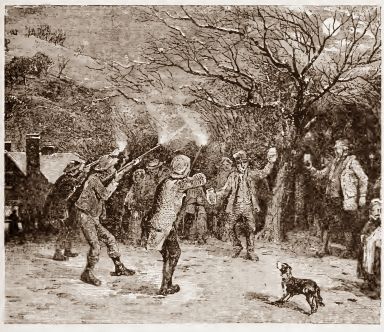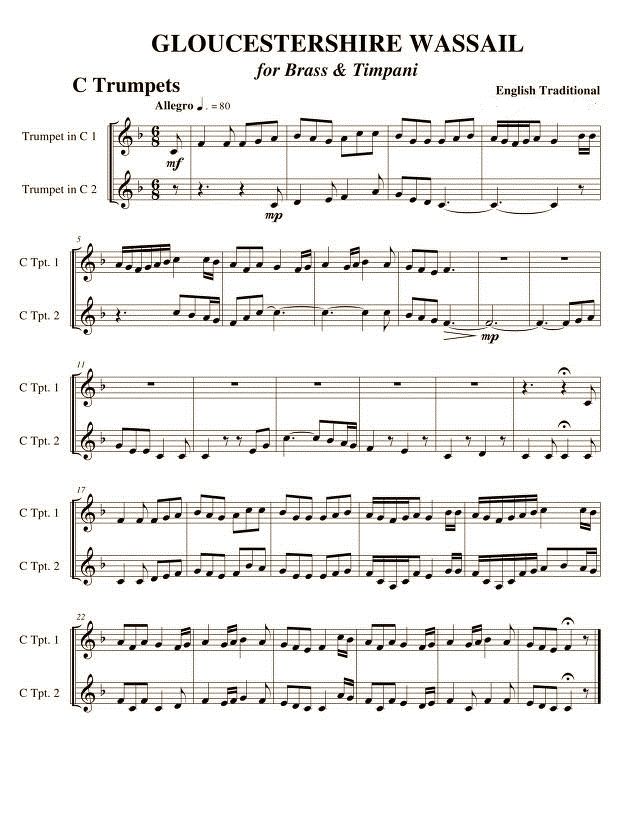One ancient Christmas custom is the wassail, which
refers to the toast, the practice and the drink. The toast comes from
the Middle English wæs hæl meaning ‘be healthy’ or, as we still say,
‘good health’ and the response was drinc hæl – ‘drink healthy’. The word
hæl remains in modern English as ‘hale’ meaning ‘well’, as in ‘hale and
hearty’.
 |
| The Wassail Bowl |
A communal drinking bowl, the wassail bowl, would be held by one
person who would toast his neighbour ‘wæs hæl’ and when the response ‘drinc
hæl’ came, the bowl would be passed with a kiss, drunk from and the toast
repeated to the next in the company. The bowl would be filled with Lambs
Wool, a drink made from sweetened ale or cider spiced with nutmeg, cinnamon
and ginger, into which roasted apples were added, (In A Midsummer Night’s
Dream, Puck says, “And sometimes lurk I in a gossip's bowl, In very likeness of a roasted crab.”)
 |
| Wassailing the Orchard |
In southern counties,
mulled cider was used, and the wassailers would visit the cider apple and other
fruit tree orchards and sing the trees awake, and scare off the evil spirits,
ensuring a good harvest in the following year. The details of the ceremony
differed from village to village and from county to county, but the central
elements of the procession, the singing, the wassail drinking and decking the
trees with slices of toast soaked in the bowl (to attract Robins), were common
to most. Another practice was ‘rough music’ which, as the name suggests, was a
raucous performance on drums, trumpets and other instruments, with kettles and
pans being rattled and banged, accompanied by whistles and roars, all meant to
scare away unwanted influences and spirits.
 |
| Wassailing in the Town |
In other areas, the wassailers
would go from house to house, singing and collecting alms, and either offering
people a drink from the bowl or taking an empty bowl, expecting it to be
filled. There were a great many old wassailing songs, sung to ancient tunes,
with some very poetic and others mere doggerel but all dating far back in time.
Perhaps the most famous is the Gloucestershire Wassail,
“Wassail, wassail, all over the town,Our toast it is white, our ale it is brown;Our bowl it is made of the mapling [or rosemary] tree,With the wassailing bowl we will drink unto thee.”
 |
| The Gloucestershire Wassail |
Another famous wassail, often sung by children, is;
“Here we come a wassailing,Among the leaves so green,Here we come a wandering,So fair to be seen.”
The poet Robert Herrick wrote a short verse, Christmas Eve an
other ceremonie,
“Wassaile the Trees, that they may beareYou many a Plum, and many a Peare:For more or lesse fruits they will bring,As you doe give them Wassailing.”
The wassail
songs are a strange combination of the traditional drinking songs and more
religious elements, brought together in an unusual and unexpected mix.
 |
| Wassailing |
Wassailing began on Christmas Eve and could continue to Twelfth Night, when the
celebrations ended with more spiced ale and special spiced cakes, hence the
expression ‘Cakes and Ale.’ If you fancy trying a wassail bowl of your
own, this is a recipe from the 1870s:
“Heat in a saucepan a pint of Burton ale, with half a pound of sugar, a grated nutmeg, and half an ounce of grated ginger; after it has just boiled up, add a quart more ale, four glasses of golden sherry, and a couple of ounces of lump sugar that has been rubbed over the outside of a lemon. Add also a few thin slices of lemon. Make the whole mixture hot without boiling it, and add half a dozen roasted apples that have had the cores stamped out and cut, but that have not been peeled.”
Wassailing fell
from favour during the Victorian age and was replaced by the similar custom of
carolling. It is said that the pub name The Pig and Whistle comes from a
corruption of Peg and Wassail, in reference to the Peg tankards
introduced in Saxon times.
No comments:
Post a Comment